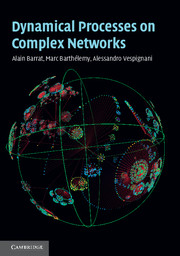Book contents
- Frontmatter
- Contents
- Preface
- Acknowledgements
- List of abbreviations
- 1 Preliminaries: networks and graphs
- 2 Networks and complexity
- 3 Network models
- 4 Introduction to dynamical processes: theory and simulation
- 5 Phase transitions on complex networks
- 6 Resilience and robustness of networks
- 7 Synchronization phenomena in networks
- 8 Walking and searching on networks
- 9 Epidemic spreading in population networks
- 10 Social networks and collective behavior
- 11 Traffic on complex networks
- 12 Networks in biology: from the cell to ecosystems
- 13 Postface: critically examining complex networks science
- Appendix 1 Random graphs
- Appendix 2 Generating functions formalism
- Appendix 3 Percolation in directed networks
- Appendix 4 Laplacian matrix of a graph
- Appendix 5 Return probability and spectral density
- References
- Index
2 - Networks and complexity
Published online by Cambridge University Press: 05 September 2012
- Frontmatter
- Contents
- Preface
- Acknowledgements
- List of abbreviations
- 1 Preliminaries: networks and graphs
- 2 Networks and complexity
- 3 Network models
- 4 Introduction to dynamical processes: theory and simulation
- 5 Phase transitions on complex networks
- 6 Resilience and robustness of networks
- 7 Synchronization phenomena in networks
- 8 Walking and searching on networks
- 9 Epidemic spreading in population networks
- 10 Social networks and collective behavior
- 11 Traffic on complex networks
- 12 Networks in biology: from the cell to ecosystems
- 13 Postface: critically examining complex networks science
- Appendix 1 Random graphs
- Appendix 2 Generating functions formalism
- Appendix 3 Percolation in directed networks
- Appendix 4 Laplacian matrix of a graph
- Appendix 5 Return probability and spectral density
- References
- Index
Summary
Undeniably, the visualizations of the Internet or the airport network convey the notion of intricate, in some cases haphazard, systems of a very complicated nature. Complexity, however, is not the same as the addition of complicated features. Despite the fact that there is no unique and commonly accepted definition of complexity – it is indeed very unlikely to find two scientists sharing the same definition of complex system – we discuss from what perspectives many real-world networks can be considered as complex systems, and what are the peculiar features signaling this occurrence. In this chapter we review the basic topological and dynamical features that characterize real-world networks and we attempt to categorize networks into a few broad classes according to their observed statistical properties. In particular, self-organized dynamical evolution and the emergence of the small-world and scale-free properties of many networks are discussed as prominent concepts which have led to a paradigm shift in which the dynamics of networks have become a central issue in their characterization as well as in their modeling (which will be discussed in the next chapter). We do not aim, however, at an exhaustive exposition of the theory and modeling of complex networked structures since, as of today, there are reference textbooks on these topics such as those by Dorogovtsev and Mendes (2003), Pastor-Satorras and Vespignani (2004), and Caldarelli (2007), along with journal reviews by Albert and Barabási (2002), Dorogovtsev and Mendes (2002), Newman (2003c), and Boccaletti et al. ([2006]).
- Type
- Chapter
- Information
- Dynamical Processes on Complex Networks , pp. 24 - 49Publisher: Cambridge University PressPrint publication year: 2008
- 2
- Cited by



